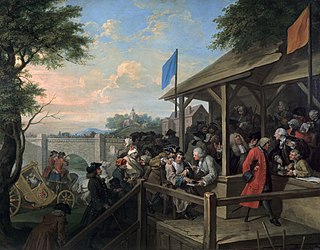Armagh or County Armagh is a former county constituency in the House of Commons of the United Kingdom. It was a two-member constituency in Ireland from 1801 to 1885 and a single-member constituency in Northern Ireland from 1922 to 1950. It was replaced in boundary changes in 1983.
County Antrim is a former county constituency in the House of Commons of the United Kingdom. It was a two-member constituency in Ireland from 1801 to 1885 and in Northern Ireland from 1922 to 1950.
County Longford was a parliamentary constituency in Ireland, which returned two Members of Parliament (MPs) to the House of Commons of the Parliament of the United Kingdom from 1801 to 1885, and one MP from 1918 to 1922.
County Tyrone is a former UK Parliament constituency in Ireland, returning two Members of Parliament (MPs).
Cork City was a parliamentary constituency in Ireland, represented in the Parliament of the United Kingdom. From 1880 to 1922 it returned two members of parliament (MPs) to the House of Commons of the United Kingdom of Great Britain and Ireland. From 1922 it was not represented in the UK Parliament, as it was no longer in the UK.
Athlone was a parliamentary constituency in Ireland, which from 1801 to 1885 returned one Member of Parliament (MP) to the House of Commons of the United Kingdom of Great Britain and Ireland.
Downpatrick was a United Kingdom Parliament constituency in Ireland, returning one MP. It was an original constituency represented in Parliament when the Union of Great Britain and Ireland took effect on 1 January 1801.
Youghal was a United Kingdom Parliament constituency in Ireland returning one MP. It was an original constituency represented in Parliament when the Union of Great Britain and Ireland took effect on 1 January 1801.
Wexford Borough was a United Kingdom Parliament constituency, in Ireland, returning one Member of Parliament (MP). It was an original constituency represented in Parliament when the Union of Great Britain and Ireland took effect on 1 January 1801.
Kinsale was a United Kingdom Parliament constituency in Ireland, returning one MP. It was an original constituency represented in Parliament when the Union of Great Britain and Ireland took effect on 1 January 1801.
Waterford City was a United Kingdom parliamentary constituency, in southeast Ireland.
Limerick City was a United Kingdom Parliament constituency in Ireland. It returned one MP 1801–1832, two MPs 1832–1885 and one thereafter. It was an original constituency represented in Parliament when the Union of Great Britain and Ireland took effect on 1 January 1801. It ceased to be represented in the United Kingdom Parliament in 1922.
Galway Borough was a United Kingdom Parliament constituency in Ireland. It returned one MP from 1801 to 1832, two MPs from 1832 to 1885 and one MP from 1885 to 1918. It was an original constituency represented in Parliament when the Union of Great Britain and Ireland took effect on 1 January 1801.
Dublin University is a university constituency in Ireland, which elects three senators to Seanad Éireann, the senate of the Oireachtas. Its electorate comprises the undergraduate scholars and graduates of the University of Dublin, whose sole constituent college is Trinity College Dublin, so it is often also referred to as the Trinity College constituency. Between 1613 and 1937 it elected MPs or TDs to a series of representative legislative bodies.
Belfast was an Irish borough constituency in the House of Commons of the United Kingdom of Great Britain and Ireland. Comprising the city of Belfast, it elected one Member of Parliament (MP) from 1801 to 1832, and then two MPs from 1832 until the constituency was divided by the Redistribution of Seats Act 1885 before the 1885 general election.
Bristol was a two-member constituency, used to elect members to the House of Commons in the Parliaments of England, Great Britain (1707–1800), and the United Kingdom. The constituency existed until Bristol was divided into single member constituencies in 1885.
Portsmouth was a borough constituency based upon the borough of Portsmouth in Hampshire. It returned two members of parliament (MPs) to the Parliaments of England, Great Britain and from 1801 the House of Commons of the Parliament of the United Kingdom, elected by the bloc vote system.
Liskeard was a parliamentary borough in Cornwall, which elected two Members of Parliament (MPs) to the House of Commons from 1295 until 1832, and then one member from 1832 until 1885. The constituency was abolished by the Redistribution of Seats Act 1885.

Oxfordshire was a county constituency of the House of Commons of the Parliament of England then of the Parliament of Great Britain from 1707 to 1800 and of the Parliament of the United Kingdom from 1801 to 1885. It was represented by two Members of Parliament. In 1832 this was increased to three Members of Parliament. The constituency was abolished in 1885, being split into three single member divisions.
A 1831 by-election was held in the Parliament of the United Kingdom constituency of Londonderry City between 28 March and 2 April 1831. It was held after the 1830 general election in the constituency was declared void by the House of Commons following an election petition. The grounds for the petition were that the election's winner Sir Robert Ferguson, 2nd Baronet, was also the constituency's returning officer by virtue of his position as mayor of the city. Ferguson and his 1830 opponent Captain John Richard James Hart both stood in the 1831 by-election. The result was similar to that of the preceding year and Ferguson was returned. Less than a month after the by-election, Parliament was dissolved and the 1831 United Kingdom general election was called, in which Ferguson also won.

